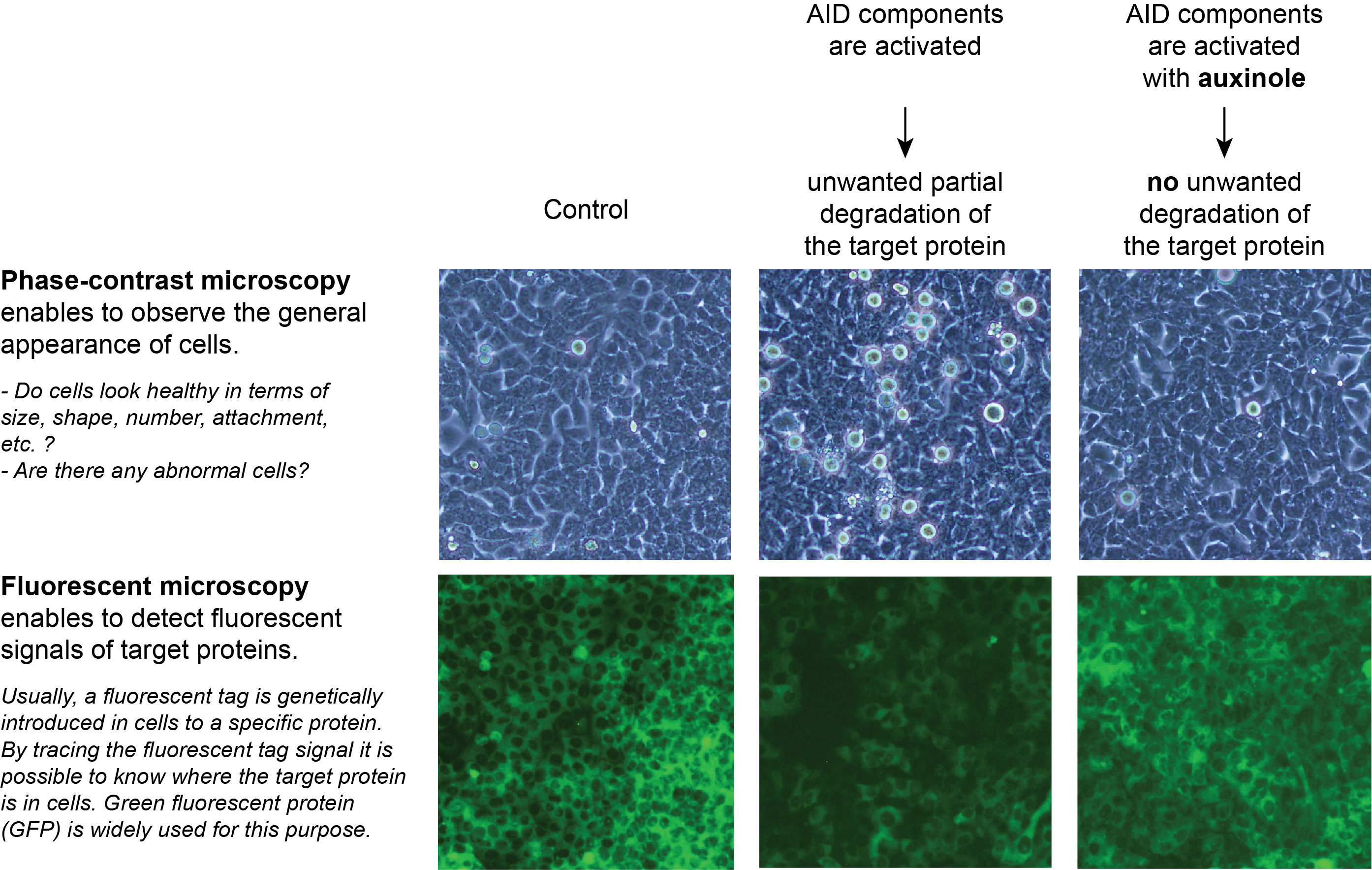November 19, 2020
Development of a small chemical that greatly improves Auxin-Inducible Degron (AID) technology for protein function research
SOKENDAI Publication Grant for Research Papers program year: 2020
Aisha Yesbolatova, Genetics
Generation of conditional auxin-inducible degron (AID) cells and tight control of degron-fused proteins using the degradation inhibitor auxinole
Journal: Methods publish year: 2019
DOI: 10.1016/j.ymeth.2019.04.010

Top images are taken with a phase-contrast microscope and demonstrate the shape of cultured human cells. Bottom images are taken with a fluorescent microscope and show the signal of the green fluorescent protein (GFP) that is fused with and, therefore, represents the target protein. (Left) In the control case, the cells are healthily spread and the GFP signal intensity is high. (Center) However, when AID components are activated even without the inducer auxin, the target protein is partially degraded as evident from the appearance of sick circular cells and reduction of GFP. (Right) The use of auxinole helps to avoid unwanted target protein degradation preserving cells healthy and preventing the GFP reduction.
Proteins are one of the key molecules of life and play a crucial role in ultimately every cellular process, such as metabolism, cell division, signaling and transport within and between cells. Targeted degradation is a useful method for studying protein function. When a protein is degraded, researchers can observe the effects this manipulation exerts on cells or an organism and deduce the specific function of this protein. Thus, several techniques have been developed to degrade proteins and analyze their functions. Among them is the plant hormone-based Auxin-Inducible Degron (AID) technology developed by Kanemaki group. What makes AID stand out among other techniques is the extreme speed and specificity of degradation as well as the possibility to target virtually any protein. The only drawback of AID is that sometimes even without auxin the interaction between the components of the system happens. Previously, the AID creators have attempted to regulate one component of the system in a switch on-off manner, however, they still observed the undesirable partial target protein degradation. In this study, a molecule called auxinole that prevents unwanted degradation has been developed. Auxinole was originally developed as a suppressor of the auxin pathway in plants. The use of this small chemical allows for tight control of protein degradation with AID in human cells. Along with other genetic improvements reported in the study, this finding significantly contributes to the robustness and versatility of AID making it a universal tool for researchers worldwide to study protein function.
Aisha Yesbolatova, Toyoaki Natsume, Ken-ichiro Hayashi, and Masato T. Kanemaki. "Generation of conditional auxin-inducible degron (AID) cells and tight control of degron-fused proteins using the degradation inhibitor auxinole." Methods (online publication on April 24, 2019, and in press). https://doi.org/10.1016/j.ymeth.2019.04.010
Aisha YESBOLATOVA, School of Life Science, Dept. Genetics

Aisha Yesbolatova is a second-year student of a five-year doctoral program at the Department of Genetics, SOKENDAI (The Graduate University for Advanced Studies), supported by Japanese Government (Monbukagakusho: MEXT) Scholarship. Graduated Nazarbayev University in Kazakhstan, she has interned at and later joined the Molecular Cell Engineering laboratory at National Institute of Genetics and currently conducts research under the supervision of Professor Masato Kanemaki.
